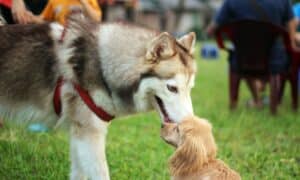“This post contains affiliate links, and I will be compensated if you make a purchase after clicking on my links.”
Have you ever considered the fact that you should learn to speak in your dog’s language? If not, just remember that your little (big?) fur ball is definitely talking to you! Have you ever considered you are a teacher if you own a dog? What are you teaching is the language you speak as you communicate with your dog. Dogs are very smart and learn far more than most people realize from what we say to them. Simple commands like sit, speak, no, and come are just a few of the words we speak to them and they learn what these words mean as we show them what each word means. You also need to speak in your dog’s language as well. Say what? Yes, dogs speak through their body language.
Speak in your dog’s language
Part of interpreting the body language is to remember to keep it in context. For example, when Rover is wagging his tail while wiggling all over, and has a happy look, that means he is happy. However, don’t confuse a tail wagging with the dog being friendly. A dog can wag his tail but be bristling his hair and in an aggressive posture. You see this and it is time to back off because you about to be bitten. He brings you a toy—it is play time. He brings you his leash—time for a walk. Tail tucked between his legs—he knows he has been a bad boy. And your dog has many more methods of communicating his moods and feelings if we humans just take the time to pay attention and learn.
Another of these methods is verbal, such as a growl — it could be a warning, or “toy tug” play time. Again, interpret it in context. As described in an article on Dogster.com:
This means “back off.” You’ll see a dog growl when another dog gets interested in his food. Your dog may growl at a stranger he doesn’t like or he may growl at you when you try to take his toy away. It’s actually a very effective way of communicating and actually signals that you can probably negotiate that toy away.
That same article explains the one body language sign you had better pay attention to:
When a dog is in an aggressive stance and silent, there is the most danger.
The common preconceived idea that dogs do things to get back at us is totally false. Take making a mess on the floor while you are gone. Even though the dog has been house broken is NOT his way of being spiteful because you left him alone all day. He or she simply had to do “their business” and you were not home to let them out. Becoming stern with your dog in this situation is not going to register with the dog because the mess was made long before you came home. He will only understand you are angry but not know why.
Just as people need their space, so does your dog. Let them have all the space they need and try not to force them to do what you want at times like this. Learning to speak your dog’s language is all part of both our and the dog’s learning process.
Let us be honest here—some dogs just do not like humans and usually they have a good reason for this. They have been abused, abandoned, or had to live on their own. Keep your distance when you encounter these dogs and accept it for what it is. But the vast majority of dogs are very friendly not only with their owners but with strangers as well. Some dogs are one person dogs while others want to be everyone’s friend. Learning to speak in your dog’s language is fun as well as informative.
Have you consciously learned to do this? Can you tell any “before & after” differences in the way the dog responds to you? If so, please share below.
























Judy
says:I foster abandoned stray dogs that are picked up by the pound. They do tests with these dogs to look for signs of aggression. I rescued a 4 month old German shepherd cross that would freeze when a stranger put a stick into his food bowl to take it away and he growled when they tried to take a rawhide stick away from him. This dog was left behind when his people moved away. God knows how long he was left there. The pound was going to put him to sleep. I said I would take him. I started hand feeding him for the first 2 days then put some food in his bowl, told him to leave it and I took the bowl away. No food aggression at all.
Just because a dog will freeze when someone takes his food away when he probably hadn’t eaten for a week or more is not fair. I would bite someone if that had been me.The third strike against the puppy was that he wiggled too much. REALLY!!! I thought that was a happy sign. I am disgusted by these so called tests. How many innocent dogs have died from their ignorance.
James Yockey
says:Just my two cents……. It has been my experience and effective to incorporate a hand signal with every command, or request, of your pet. You will be shocked that after a time, how they will respond merely to your physical commands. Sure has worked for me as the author is correct in that pets are far more intelligent and willing to please and learn than we give them credit for. The key is consistency and repetition. You might be amazed in the results.
Kim Beard
says:We have always put hand commands with verbal. have owned rottweilers for over 25 years. this comes in handy when we have company. no interrupted adult conversations to tell the dogs to lie down. just a simple hand gesture and it’s done. and yes, our dogs do talk to us. they have a way of letting us know what they want. dogs are amazing people. the more i get to know humans, the more i like my dog.